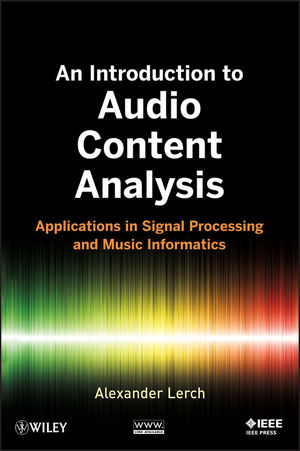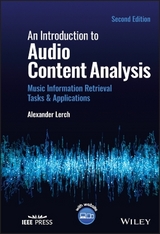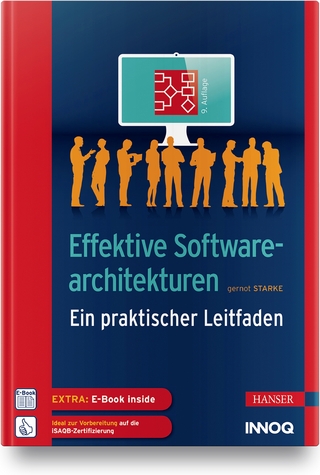
An Introduction to Audio Content Analysis – Applications in Signal Processing and Music Informatics
John Wiley & Sons Inc (Verlag)
978-1-118-26682-3 (ISBN)
- Titel erscheint in neuer Auflage
- Artikel merken
ALEXANDER LERCH, PhD, is Managing Director and co-owner of zplane.development, a research and development firm of licensable technology for digital audio signal processing for both the music software industry and major audio content distributors. Dr. Lerch also teaches audio content analysis at the Technical University of Berlin.
List of Figures xiii List of Tables xvii Preface xix Acronyms xxi List of Symbols xxv 1 Introduction 1 1.1 Audio Content 3 1.2 A Generalized Audio Content Analysis System 4 2 Fundamentals 7 2.1 Audio Signals 7 2.1.1 Periodic Signals 7 2.1.2 Random Signals 9 2.1.3 Sampling and Quantization 9 2.1.4 Statistical Signal Description 13 2.2 Signal Processing 14 2.2.1 Convolution 14 2.2.2 BlockBased Processing 18 2.2.3 Fourier Transform 20 2.2.4 Constant Q Transform 23 2.2.5 Auditory Filterbanks 24 2.2.6 Correlation Function 24 2.2.7 Linear Prediction 28 3 Instantaneous Features 31 3.1 Audio PreProcessing 33 3.1.1 DownMixing 33 3.1.2 DC Removal 33 3.1.3 Normalization 34 3.1.4 DownSampling 34 3.1.5 Other PreProcessing Options 35 3.2 Statistical Properties 35 3.2.1 Arithmetic Mean 36 3.2.2 Geometric Mean 36 3.2.3 Harmonic Mean 36 3.2.4 Generalized Mean 36 3.2.5 Centroid 37 3.2.6 Variance and Standard Deviation 37 3.2.7 Skewness 38 3.2.8 Kurtosis 39 3.2.9 Generalized Central Moments 40 3.2.10 Quantiles and Quantile Ranges 40 3.3 Spectral Shape 41 3.3.1 Spectral Rolloff 42 3.3.2 Spectral Flux 44 3.3.3 Spectral Centroid 45 3.3.4 Spectral Spread 47 3.3.5 Spectral Decrease 48 3.3.6 Spectral Slope 49 3.3.7 Mel Frequency Cepstral Coefficients 51 3.4 Signal Properties 54 3.4.1 Tonalness 54 3.4.2 Auto Correlation Coefficients 61 3.4.3 Zero Crossing Rate 62 3.5 Feature PostProcessing 63 3.5.1 Derived Features 64 3.5.2 Normalization and Mapping 65 3.5.3 Subfeatures 66 3.5.4 Feature Dimensionality Reduction 66 4 Intensity 71 4.1 Human Perception of Intensity and Loudness 71 4.2 Representation of Dynamics in Music 73 4.3 Features 73 4.3.1 Root Mean Square 73 4.4 Peak Envelope 76 4.5 PsychoAcoustic Loudness Features 77 4.5.1 EBU R128 78 5 Tonal Analysis 79 5.1 Human Perception of Pitch 79 5.1.1 Pitch Scales 79 5.1.2 Chroma Perception 81 5.2 Representation of Pitch in Music 82 5.2.1 Pitch Classes and Names 82 5.2.2 Intervals 83 5.2.3 Root Note, Mode, and Key 83 5.2.4 Chords and Harmony 86 5.2.5 The Frequency of Musical Pitch 88 5.3 Fundamental Frequency Detection 91 5.3.1 Detection Accuracy 92 5.3.2 PreProcessing 94 5.3.3 Monophonic Input Signals 97 5.3.4 Polyphonic Input Signals 103 5.4 Tuning Frequency Estimation 106 5.5 Key Detection 108 5.5.1 Pitch Chroma 108 5.5.2 Key Recognition 112 5.6 Chord Recognition 116 6 Temporal Analysis 119 6.1 Human Perception of Temporal Events 119 6.1.1 Onsets 119 6.1.2 Tempo and Meter 122 6.1.3 Rhythm 122 6.1.4 Timing 123 6.2 Representation of Temporal Events in Music 123 6.2.1 Tempo and Time Signature 123 6.2.2 Note Value 124 6.3 Onset Detection 124 6.3.1 Novelty Function 125 6.4 Beat Histogram 133 6.4.1 Beat Histogram Features 134 6.5 Detection of Tempo and Beat Phase 135 6.6 Detection of Meter and Downbeat 136 7 Alignment 139 7.1 Dynamic Time Warping 139 7.1.1 Example 143 7.1.2 Common Variants 144 7.1.3 Optimizations 145 7.2 AudiotoAudio Alignment 146 7.2.1 Ground Truth Data for Evaluation 147 7.3 AudiotoScore Alignment 148 7.3.1 RealTime Systems 148 7.3.2 Non RealTime Systems 149 8 Musical Genre, Similarity and Mood 151 8.1 Musical Genre Classification 151 8.1.1 Musical Genre 152 8.1.2 Feature Extraction 154 8.1.3 Classification 155 8.2 Related Research Fields 156 8.2.1 Music Similarity Detection 156 8.2.2 Mood Classification 158 8.2.3 Instrument Recognition 161 9 Audio Fingerprinting 163 9.1 Fingerprint Extraction 164 9.2 Fingerprint Matching 165 9.3 Fingerprinting System: Example 166 10 Music Performance Analysis 169 10.1 Musical Communication 169 10.1.1 Score 169 10.1.2 Music Performance 170 10.1.3 Production 172 10.1.4 Recipient 172 10.2 Music Performance Analysis 172 10.2.1 Analysis Data 174 10.2.2 Research Results 177 A Convolution Properties 181 A.1 Identity 181 A.2 Commutativity 181 A.3 Associativity 182 A.4 Distributivity 183 A.5 Circularity 183 B Fourier Transform 185 B.1 Properties of the Fourier Transformation 186 B.1.1 Inverse Fourier Transform 186 B.1.2 Superposition 186 B.1.3 Convolution and Multiplication 186 B.1.4 Parseval s Theorem 187 B.1.5 Time and Frequency Shift 188 B.1.6 Symmetry 188 B.1.7 Time and Frequency Scaling 189 B.1.8 Derivatives 190 B.2 Spectrum of Example Time Domain Signals 190 B.2.1 Delta Function 190 B.2.2 Constant 190 B.2.3 Cosine 190 B.2.4 Rectangular Window 191 B.2.5 Delta Pulse 191 B.3 Transformation of sampled time signals 191 B.4 Short Time Fourier Transform of Continuous Signals 192 B.4.1 Window Functions 193 B.5 Discrete Fourier Transform 195 B.5.1 Window Functions 196 B.5.2 Fast Fourier Transform 197 C Principal Component Analysis 199 C.1 Computation of the Transformation Matrix 200 C.2 Interpretation of the Transformation Matrix 200 D Software for Audio Analysis 201 D.1 Software Frameworks & Applications 202 D.1.1 Marsyas 202 D.1.2 CLAM 202 D.1.3 jMIR 203 D.1.4 CoMIRVA 203 D.1.5 Sonic Visualiser 203 D.2 Software Libraries & Toolboxes 204 D.2.1 Feature Extraction 204 D.2.2 Plugin Interfaces 205 D.2.3 Other Software 206 References 207 Index 237
| Erscheint lt. Verlag | 9.10.2012 |
|---|---|
| Verlagsort | New York |
| Sprache | englisch |
| Maße | 178 x 254 mm |
| Gewicht | 605 g |
| Themenwelt | Mathematik / Informatik ► Informatik |
| Technik ► Elektrotechnik / Energietechnik | |
| Technik ► Nachrichtentechnik | |
| ISBN-10 | 1-118-26682-X / 111826682X |
| ISBN-13 | 978-1-118-26682-3 / 9781118266823 |
| Zustand | Neuware |
| Haben Sie eine Frage zum Produkt? |
aus dem Bereich



